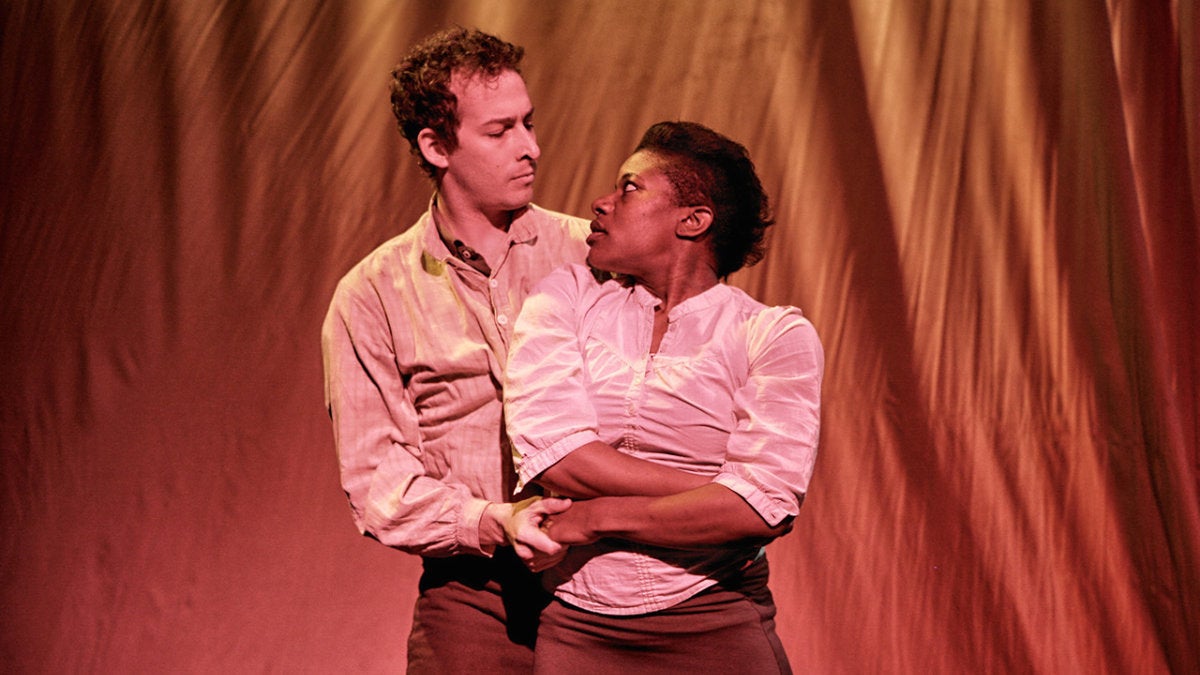Fringe reviews: ‘Underground Railroad Game,’ ‘The Shoplifters,’ ‘Exit the King’ and ‘Zombies … with Guns’

Scott Sheppard and Jennifer Kidwell is 'Underground Railroad Game.' (Photo courtesy of Tamara Rodriguez) Reichberg
Underground Railroad Game
Raw, revealing, funny and poignant – “Underground Railroad Game” is hands-down the best piece I’ve seen in the Fringe Festival this year and in many years. Its two players, Jennifer Kidwell and Scott Sheppard, devised the show about race and American life beginning in Civil War times and ending today but, of course, not really ending at all. Race is arguably the toughest issue to speak about in our culture, and the mighty triumph of “Underground Railroad Game” is the ability of Kidwell and Sheppard to address it head-on, from various sides and even through the back door.
This piece from Lightning Rod Special, a group with five artistic directors including Kidwell and Sheppard, comes directly out of Sheppard’s childhood in Hanover, Pa. There, he played a Civil War game in middle-school in order to learn about slavery and the war. In “Underground Railroad Game,” Kidwell, who is black, and Sheppard, who is white, are the two teachers running the school’s Civil War learning project. They’ve divided the kids into Union and Continental soldiers. Students in the Union must convey “slave dolls” into boxes around the school that represent safe houses on the underground railroad. Students in the Confederacy must steal the dolls to sell them back into slavery down South.
Points are assigned for the task. The challenge begins. “It’s up to you guys,” Sheppard tells the audience, which represents the students but never really plays the game. “Are you going to reaffirm or rewrite history?” What “Underground Railroad Game” itself reaffirms is this: No matter what our race may be, in America it comes with baggage we lug – and we can’t seem to put it down.
The show, which FringeArts is producing for the festival, is bold in the way it handles its subject – prepare for nudity, heavy sex references and what some people would consider inflammatory. And definitely leave the kids at home. “Underground Railroad Game” is staged with a fluid arc, despite its almost dreamlike storytelling, by the theater artist Sarah Sanford. With meticulously created lighting design (by Oona Curley) sound (Alex Bechtel), simple scenery (Steven Dufala) and changes of costumes designed by Katherine Fritz on-stage and off, Sanford launches the play into zones both real and not. A scene in front of the students may shift to a dream the teachers are having about each other, then into the personal time they begin to spend together.
Through all of it, race is an issue – when the teachers talk with one another about the possibility of a relationship, when they try to address student assemblies about their Civil War game or teach them what slavery was like. Or when the two teachers, alone in the bedroom, use their races to ignite their fantasies. In one jaw-dropping scene, foreplay becomes tantamount to selling a slave at auction. In another, the teachers awkwardly dress down the students after someone scrawls a racial epithet on a sign being used in the school’s game – a nasty act the teachers have unwittingly encouraged by their game’s very nature.
It’s heady and remarkable, and performed in the most genuine fashion by Sheppard, masterly at being awkward and vulnerable one minute and brash the next, and Kidwell, with her commanding presence and voice that – as Sheppard tells her – rolls over you like a river.
How it all ends is in a blur, with one character from the past and another from the present walking together and then, suddenly, apart. The scene is opaque. You sense that the play has no real resolution. And maybe it doesn’t end at all. In that, “Underground Railroad Game” is like the discussion of race it explores.
_Underground Railroad Game, from Lightning Rod Special and produced by FringeArts, runs through Sept. 12 at Christ Church Neighborhood House, off Second Street north of Market and to the side of Christ Church.
The Shoplifters
As it has in the past, 1812 Productions opens its season in the Fringe — this time, with Morris Panych’s new play about a champion shoplifter, which had its world premiere last season in a production in Washington, D.C. The comedy gets its juice by slamming an amoral voice against a rigid God-fearing one, then tries to meld the two, sprinkling laughs along the way.
Really, though, the play goes round and round. After a while, we’ve run the gamut on whether it’s okay to steal from a large supermarket corporation or whether it’s okay to fully punish such theft without considering the circumstances of the thief. None of it seemed all that okay to me by the second act, even though the dialogue is often amusing and sometimes more than that.
What is okay is the production, staged by 1812’s artistic director and chief muse, Jennifer Childs. She and the first-rate actors lift “The Shoplifters” to a level higher than the play’s plateau. The wonderful Mary Martello plays the shoplifting queen with an unbreachable attitude that lets her cling to her most disingenuous defenses. Johnnie Hobbs Jr. is wily as the security chief with his own ideas about the rules.
Marla Burkholder is the poverty-level workaday coat checker who gets caught up in the shoplifting and Daniel Fredrick is the store guard who has the law and the Ten Commandments on his side. But whose law is it, anyway? Oh no, I’m beginning to talk like the shoplifter herself.
_The Shoplifters, presented by 1812 Productions, runs through Sept. 20 at the Arden Theatre, on Second Street just north of Market Street.
Exit the King
This is the state of the king, as detailed by his court: His palace is crumbling, his fields are fallow, his fountains are sinking and even the Milky Way above him seems to be curdling. And did we mention that he’s being told by everyone – his astronomer/doctor (Susan Giddings) chief among them – that he’s hours from dying?
Eugène Ionesco’s absurdist “Exit the King” has metaphors that keep shifting – primarily, the king himself. Is he supposed to be God? Ego? Ideals?
And what about those in his inner circle – his pushy former wife (Patricia Durante), his current naïve trophy queen (Anna Lou Hearn), his housekeeper (Jenna Kuerzi) and his wind-shifting guard (Bob Schmidt)? Are they The Truth or do they each have two faces?
Ionesco’s 1962 play lives in an intellectual minefield – that’s both the fun of it and the frustration in watching it. In the Idiopathic Ridiculopathy Consortium production directed by the company’s leader, Tina Brock, the actors start off so shrill and at such extremes, there’s nowhere to go from there. As things get worse for the kingdom, they seem no worse than they were at a high-decibel level 15 minutes back. As things get worse for the king himself, all the characters who’ve been yelling at him are … still yelling at him.
This high-energy exposition – as if to say “this is Theater of the Absurd!” – nearly steals focus from the king but Robb Hutter, portraying him, makes a good go of it. His portrayal frequently reminded me of Tiny Tim from the way he looks and sounds, which may not be a bad thing for this production. At least he seemed human against all his cartoonish pals.
The sad thing about staging “Exit the King” as a spoof comes when the play itself becomes sad at the end, as the king is guided into the netherworld by his former wife. Here, it’s magnetizing, with Brock’s direction and the eerie soundtrack (she also did the sound design) behind it, as Erica Hoelscher’s crumbling-castle set becomes more like a path out of life. And so the production feels like two plays – the one that came before the last minutes and the one you see in its final throes. It would have been more absurd if the bulk of the play were performed as more real.
_Exit the King, produced by the Idiopathic Ridiculopathy Consortium, runs through Sept. 20 on the third-floor stage of Walnut Street Theatre, Ninth and Walnut Streets.
Zombies … with Guns
I don’t know, maybe it’s just me, but zombies leave me cold even though none has ever bitten me. That aside, the latest from the normally irreverent and meaty bunch named Tribe of Fools is a disappointment on its own terms, which in this case are violence, blood and a bit of entertainment thrown into a show about Philly life after the zombie apocalypse.
That’s a dreary idea, and no number of dancing, clowning zombies can effectively counter it. When the humans are not grandstanding about their personal way to handle a zombie, they get into a lot of fighting with the zombies, or into shooting them. The humans also launch circular discussions about whether it’s more dangerous to lock up the guns in the fight against zombies or to arm themselves.
The fight direction (Michael Cosenza) and general choreography is carefully thought-out and the cast, who devised the show, is certainly up to performing the routines; a Tribe of Fools’ trademark is its blend of athleticism, movement and acting. But there’s far too much fighting in “Zombies … with Guns,” directed by Peter Smith, to make it anything more than repetitive, about a half hour’s worth of theatrical muscle in a show that clocks in at more than twice the time.
_Zombies … with Guns, produced by Tribe of Fools, runs through Sept. 12 at Luna Theater, on Eighth Street between South and Bainbridge Streets.
Click through for information about the Philly Fringe Festival, which runs through Sept. 19, although some shows run longer.
WHYY is your source for fact-based, in-depth journalism and information. As a nonprofit organization, we rely on financial support from readers like you. Please give today.




